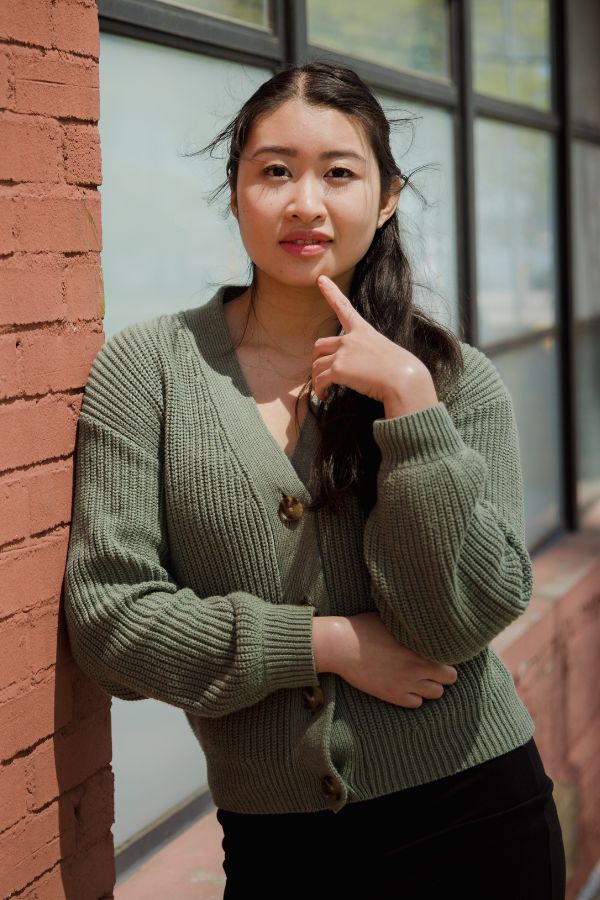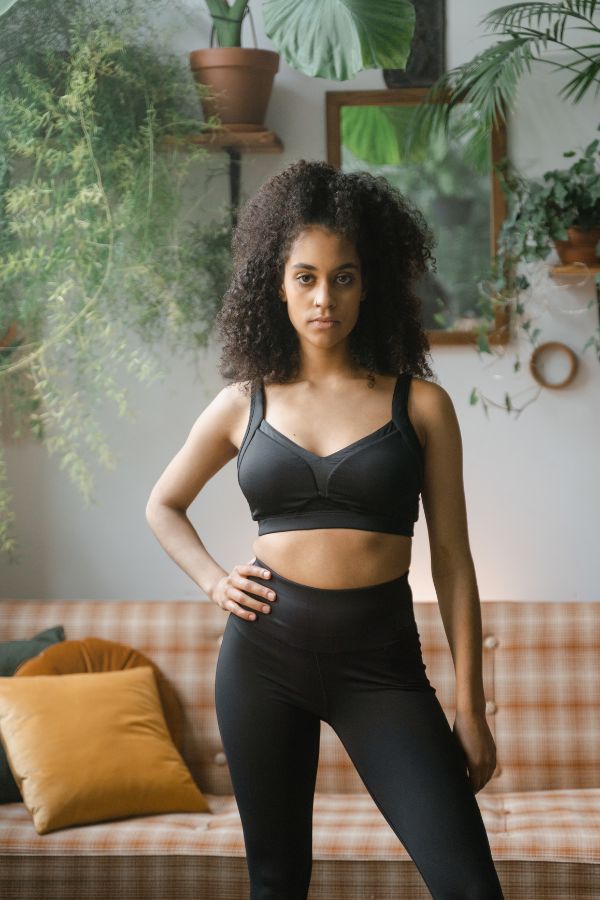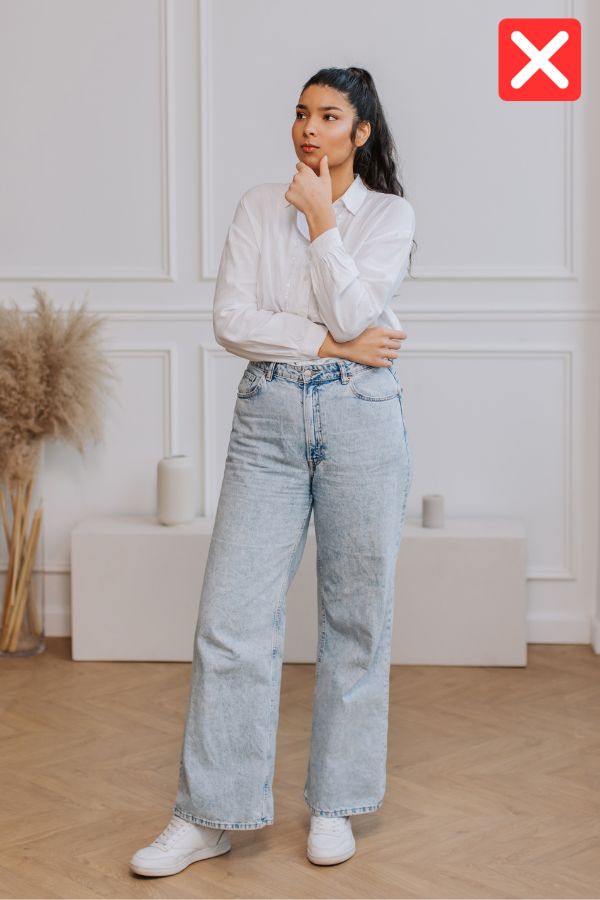Looking for fashion tips for body types that actually work? Here are four effective tools to help you dress for your body type, no matter what shape.
These fashion tips for body types are super effective for all different body shapes. There’s no “one size fits all” approach to styling. Rather it’s learning to style clothes from a different perspective. You don’t have to spend thousands on a new wardrobe or purchase a special book to get you there either.
These fashion tips will help you look at your body, clothing, and accessories from a different angle so you can learn how to dress for your body type. Using these style tips combined with the awareness of the look you want to achieve will enable you to create stylish outfits and shop for clothes you’ll actually wear.
Ready to get styling?
This post is all about fashion tips for body types.
Best Fashion Tips For Body Types
1. Style Based On Your Natural Volume Distribution
Determining your natural volume distribution is the gateway step of all fashion tips for body types. It’s incredibly effective for learning how to style clothes.
Even with these traditional body shapes and measuring methods, there’s still confusion for ladies who fall somewhere in between two or even three shapes. The way to get around this confusion is by understanding your unique volume distribution and how to balance and/or maintain it.
Balancing volume means distributing weight or emphasis between your top half (shoulders, chest, waist) with your lower half (hips and thighs). This can be done by adding clothes and accessories or by creating the illusion of length. We’ll get into both of those dressing style tips later. Knowing which method to use requires an awareness of your own natural volume distribution.
Related Post: 3 Personal Style Tips To Consider Every Day
Examples Of Natural Volume Distribution
The woman below carries the most volume in her chest and hips. Her shoulders carry slightly less volume while her waist carries significantly less volume. We see that her features are curvy, most closely resembling an hourglass body shape.

Based on the analysis in the photo above, this woman has a naturally balanced volume between her top and lower halves. When your body already has balanced volume and natural curves, you don’t need to add or subtract volume. Rather, this woman’s focus when styling should be on maintaining her natural balance of volume.
Now, let’s try a more complex example. The beauty below carries the most volume in her shoulder area. Her hips come secondary in volume, while her chest and waist carry the least. You could say she mostly resembles an inverted triangle body shape due to her broad shoulders. However, she has a slight curve between her top and lower half, and her hips are not the most narrow part of her body, so you could also say she’s a top hourglass.

Rather than getting stuck on the details of which body shape she is, we analyze the volume in the photo above. Naturally, her top half (shoulders especially) is more voluminous than her bottom half. Her focus when dressing for her body type should be to enhance the volume on her bottom half (or hip area) to match her top half. Or, use styles that detract from her broad shoulders so upper body volume is minimized.
Related Post: How To Dress Better In 2023
How To Measure Your Body For Volume Distribution
Rather than only looking at your body as one shape that needs to fit into things, break it up into different parts, taking note of where you carry the most volume. Volume also includes weight and width. Stand in front of a mirror wearing form-fitting clothing, or in your underwear or bathing suit. Take a picture of yourself and analyze each section of your body including the following:
- Shoulders
- Chest
- Waist
- Hips
- Thighs
Taking inspiration from the examples above, use your phone’s photo editor (or print out your picture) and draw lines across these body parts. Use the same colored line for body parts that are the same or very similar in width. Use a different colored line for body parts that are a different width. The horizontal lines represent your natural volume distribution.
Next, trace the silhouette of your body. This will show you your body’s natural curvature (how curvy or how straight you are). It might even be helpful to take a profile snapshot as well or at least be aware of your curves or a large tummy from the side. You may find that your front silhouette appears straighter, but you have a pronounced booty from the side.

How To Analyze Your Volume Distribution
The goal of this exercise is to take your edited picture from above and determine whether most of your volume is located in the top half of your body, the bottom half of your body, or whether it’s evenly distributed. Based on the silhouette tracing, you should be able to tell whether your top half or bottom half (or both) are volume dominant.
- If your volume is dominant on your top half, your focus in styling is to add volume to your bottom half to create a balance
- If your volume is dominant on your lower half, your focus in styling is to add volume to your top half to create a balance
- If your volume is balanced between your top and bottom half and your silhouette is curvy (e.g. an hourglass), your focus in styling is to maintain the balance of your natural silhouette and create the illusion of length (especially if you’re petite).
- If your volume is balanced between your top and bottom half and your silhouette is undefined or minimally curvy, your focus in styling is to maintain that balance of volume by breaking up the straight line of your silhouette. Do this by styling similar volume pieces on top and on bottom and cinching your waist to create shape; or use juxtaposition to enhance your volume on top or on the bottom.
If you have a large chest or tummy, your focus in styling is to elongate that area of the body in addition to the (above) volume distribution fashion tips for body types based on your volume measurements.
Related Post: 7 Amazing Plus Size Style Tips To Look Your Best
What Are The Body Types According To Fashion?
There are a few different body type classifications, but the most traditional body shapes are based on geometric shapes and/or fruit. Here are examples of each of the 5 body types and where volume is typically distributed. Use as a supplement to your analysis above.
Hourglass Body Shape

Top and bottom are balanced; curvy, with waist defined.
Related Post: How To Dress Hourglass Shape: Master Style Guide
Triangle Body Shape

Bottom is volume dominant; curvy on the bottom with waist defined.
Related Post: I’m Loving These Styles For Pear Shaped Body
Rectangle Body Shape

Top and bottom are balanced; straight with minimal waist definition.
Related Post: Most Flattering Styles For Rectangle Body Shape
Inverted Triangle Body Shape

Top is volume dominant; curvy on top with minimal waist definition.
Oval/Circle or Apple Body Shape

Top is volume dominant, little to no curves or waist definition.
Related Post: What To Wear For Apple Shape Body (And What Not To Wear)
2. Balance Volume When Styling
The next topic of fashion tips for body types is learning to balance volume when styling. If you did the volume exercise above, you should know whether to style your clothes to either create or maintain balance. Let’s dive into the style tips for creating balance.
Fashion Tips For Balancing Volume
Balancing volume means using certain clothing styles and accessories to enhance an area of the body to create a balanced silhouette. This means the volume between your top and lower body is balanced, which is more pleasing to the natural eye from a design aesthetic.
The following styles will enhance the volume of an area of the body when worn:
- White, ivory, pastels, light colors, light denim, neons, bright colors
- Horizontal stripes (super thin, muted stripes are the exception, but take colors into account)
- Strategic color blocking on top and on bottom
- Bold prints and patterns
- Boxy styles and oversized fits
- Embellishments, zippers, belt loops
- Puffed sleeves
- Sharp tailoring such as padded shoulders
- Chunky knits
- Pockets
- Heavy textures and fabrics
- Handbags worn at the area you want to add balance to
- Chunky jewelry
- Large hats
- Large waist belts or a chunky belt buckle
- Peplum
- Sharp hemlines at the area you want to add balance to
- Double-breasted jackets
- Wide collars, shawl collars
- Wide-leg, flares, and palazzo pants
Related Post: What To Wear With Bell Bottom Jeans
The following styles will help diminish and balance any volume dominant areas of the body:
- Solid, dark colors (that’s why black is so slimming)
- Slim-fitting styles
- Lightweight fabrics
- Smooth fabrics
- Styles tailored to your natural body shape
- No embellishments
- Muted vertical stripes
Let’s go over some examples of how to wear clothes for your body type based on volume balance.
Example #1: Volume Dominance On Top, Volume Isn’t Balanced

Let’s fix this: if we made the dress into a tweed skirt and styled it with a solid, dark, v-neck top, she’d have a winning look.
Example #2: Volume Dominance On Top, Volume Is Balanced

Bonus points for the long dangly earrings and the long necklace, which help to elongate your top half, which we’ll cover more in the next section.
Example #3: Volume Dominance On Bottom, Volume Isn’t Balanced

Let’s fix this: Swap the light denim for dark denim and add a waist belt.
Related Post: Style Trends | The Best Jeans For Your Body Type
Example #4: Volume Dominance On Bottom, Volume Is Balanced

Example #5: Volume Balance With Accessories, Volume Isn’t Balanced

Let’s fix this: Swap the white tote out for a black bag to maintain balance.
Example #6: Volume Balance With Accessories, Volume Is Balanced

3. Maintain Natural Volume When Styling
The next topic of fashion tips for body types is learning how to maintain volume when styling. This is important for body types that have a natural balance between their top and bottom halves. It’s also helpful when you’re adding volume to one area and need to maintain your natural volume in another area.
Here are some styles and fashion tips for maintaining natural volume balance:
- Form-fitting clothes
- Add volume evenly on top and on bottom
- Cinch your waist or have a clear demarcation point between top and bottom
- High-waisted styles to emphasize the contrast area
- Monochromatic or tonal outfits
- Wearing clothes that follow and flow with the shape of your body
Having balance infers that there are at least two parts in contrast–in this case, your top half and your bottom half. If you’re naturally curvy and have a well-defined waist, your waist already provides the contrast between your top and bottom half.
If you’re more straight, athletic, or have an undefined waist, you need to add contrast in order to harmonize that balance. Do this by cinching the waist, color blocking, or using contrasting elements on top and bottom.
More on how to style using contrast and juxtaposition in the article, below.
Related Post: How To Style Your Clothes Using Juxtaposition
Now, let’s get into some examples using these fashion tips for maintaining volume.
Example #1: Too Relaxed, Volume Isn’t Balanced

Let’s fix this: Swap the jacket for a more tailored fit and style with a navy tank instead. I’d also go for high-waisted trousers, but if she fixes the jacket and tank she can get away with a lower rise style.
Example #2: Tailored To Fit, Volume Balance Is Maintained

Example #3: Volume Balance Without Contrast

Let’s fix this: This look needs more structure. Swap the pants for a paper bag waist or a high-waisted style with a leather belt.
Example #4: Volume Balance With Contrast

Example #5: Layering To Maintain Volume Balance

Example #6: Volume Balance Using Your Body Shape

4. Style To Create Length
The last of our fashion tips for body types is to create length by styling. This is especially helpful for petite and plus-size women, as well as lengthening volume-dominant areas of the body.
Fashion tips and styles to create the illusion of length:
- Full-length pants
- Strategically-placed vertical line(s) down the center
- Long, slim-fitting or straight coats and jackets
- Long, slim-fitting vests and cardigans
- Heels and platforms
- Matching your pants/stockings and shoe color
- Matching your boot hemline to your pant or skirt hemline, so no skin shows
- Pointy toe shoes that extend the legs
- High-waisted pants and skirts
- Long necklaces and dangly earrings
- North-South totes (vertical totes with long handles)
- Long scarves
- Single pleats on trousers
- Slinkier fabrics
- High slits in long skirts and dresses
- Deep v-necks
- Monochromatic and tonal outfits
- Using the Rule of Thirds in the length and color of your clothing (your top covers 1/3, your bottoms cover 2/3)
Related Post: 5 Petite Style Tips You Might Be Missing Out On
Let’s review a few examples of how to dress for your body shape to create length.
Example #1: Choppy Look, No Length Created

Let’s fix this: Tuck the shirt into her pants (even a half tuck works) and either swap the cropped pants out for a full-length version, or swap the white sneakers for black sneakers.
Example #2: Fluid Look, Length Created

Example #3: Rule Of Thirds Ignored, No Length Created

Let’s fix this: Add length to her bottom half with a beige or taupe ankle boot that covers her ankle, so no skin shows. This will lengthen her legs, creating balance.
Related Post: How To Choose An Outfit That Slays
Example #4: Rule Of Thirds Followed, Length Created

Example #5: No Vertical Line, No Length Created

Let’s fix this: Remove the sleeves.
Example #6: Vertical Line Present, Length Created

Well, ladies, that was a lot of fashion tips for body types rolled up into one post. I recommend picking one method to start with and slowly incorporating the others as you feel comfortable. Cheers to bodies and happy styling!

TIP YOUR STYLIST?
If my style tips and fashion guides have inspired you, or you’re simply loving it here, consider leaving a tip. Any amount is greatly appreciated and supports my creative work on What Is She Wearing.
This post was all about fashion tips for body types.
Related Posts:




Leave a Reply